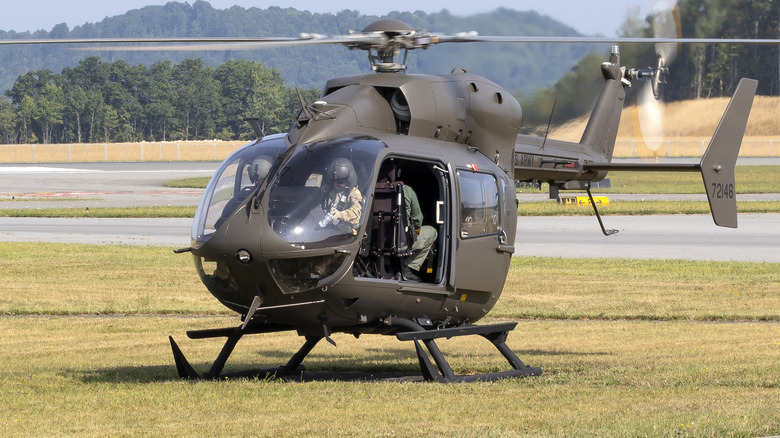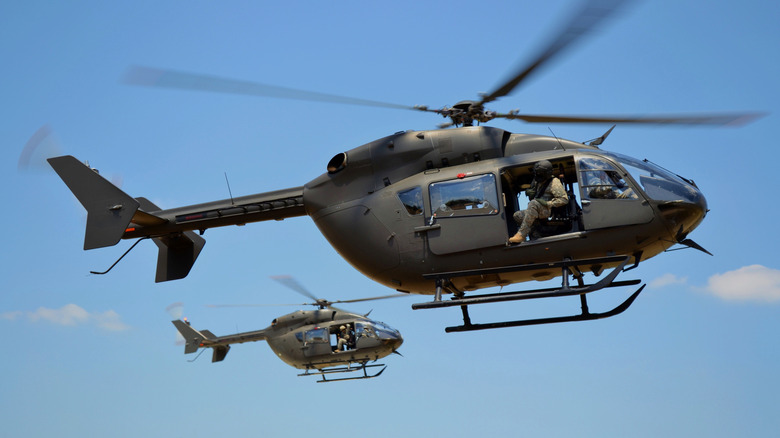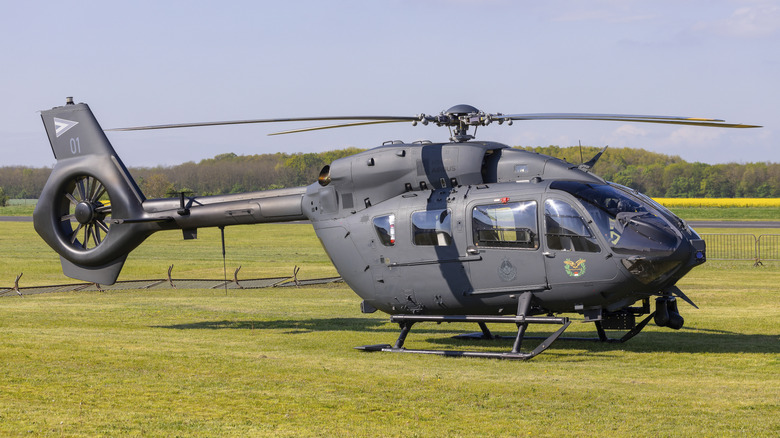What Are Lakota Helicopters Used For & Does The US Army Still Fly Them?
Since aviation has become a crucial element of the United States armed forces, and militaries around the world, for that matter, different forms of taking to the skies have been created. Fighter jets, bombers, unmanned aircraft, and more have become commonplace, and military helicopters are no exception. Countless models have served at this point, from those that have become the stuff of legend to military helicopters that endure as the strangest ever made. One of the most prominent that falls into the former category is the Eurocopter UH-72 Lakota, which is something of a jack of all trades.
While not well-suited for intense aerial combat or bombing runs, Lakota helicopters are equipped for a host of different military activities. Since their introduction back in 2006, they've taken on a wide array of missions, including training, search and rescue, reconnaissance, MEDEVAC, disaster response, firefighting, homeland defense, drug interdiction, command and control, and VIP transport.
Their versatility has made them valued elements of the Army, Army National Guard, and Navy to this day. In fact, the Lakota has clocked an astounding 1.6 million flight hours across those three fleets. With all of that in mind, one might wonder, what makes the Lakota so special that it's still used so widely? Unsurprisingly, it hasn't become such a prominent military presence without proving itself.
Why is the Lakota so widely-used by the military?
One of the most important reasons the Lakota helicopter has been a military staple is its intuitive nature, making for an aircraft that's easy to train pilots on. The senior manager for National Guard Business Development for Airbus U.S. Space & Defense, Craig Dupuy, explained as much during an interview with Breaking Defense: "The Lakota makes a good trainer as it provides an easy transition into the go-to-war modernized aircraft. You are learning on a glass cockpit. You are learning with autopilot features." He added that, at the same time, the Lakota can increase its learning curve as needed, offering a dual-engine option with greater complexity.
Continuing, Dupuy spoke about the Lakota's room for improvement. Even though it's already more than capable of handling its assigned duties, it can be tweaked as necessary to expand its use cases even further. On top of all of this, it's one of the safest training aircraft in history, and its reliability has allowed it to be flown more and train more pilots with fewer units needed to do so. Considering all of its upsides, it's no surprise that Dupuy expects the Lakota to stick around for years to come.
The Lakota helicopter is one of a few military aircraft made by Airbus. As touched on, the manufacturer has seen it fit to develop upgrades to the base model, resulting in two different, mission-specific variants.
There are distinct UH-72 Lakota variants for the military to utilize
During his Breaking Defense interview, Craig Dupuy mentioned that some changes can be and have been made to the base UH-72 Lakota model throughout the years. This has resulted in two distinct variations on the classic design that the military can decide between for different tasks. First is the UH-72A, which came first. This rendition is a twin-engine light utility helicopter that's brought in for both military and civilian operations. One of its most important uses is aviation training, where military pilots take the controls to hone their skills in rotary wing training, instrument procedures, warfighter skills, and emergency protocols.
Meanwhile, there's the UH-72B. While similar to the 72A in many ways, it improves in areas such as safety, controls, and overall power, to name a few. It also noticeably features a bearingless, five-bladed tail rotor to aid in lowering maintenance costs and increasing the acceptable load capacity. The cockpit houses the Airbus Helionix suite, an advanced interface that reduces the workload for pilots and streamlines the processes they do need to monitor.
No matter which form it takes, the UH-72 Lakota has proven a valuable asset to the U.S. military over the years — unlike some of the worst military helicopters of all time. As predicted by those in the know, chances are it'll stick around for many more years to come.


